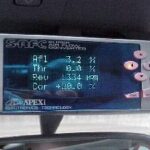An Eeprom Flasher is a crucial tool for modifying or repairing electronic devices that utilize EEPROM chips for storing firmware or data. This article focuses on a specific flasher designed for the 93c66 EEPROM, a 256 x 16-bit organized chip commonly found in older hardware. We’ll delve into the process of reprogramming this EEPROM using a specialized software and hardware setup.
Understanding the 93c66 EEPROM Flasher
The provided software, mw.exe, facilitates reading and writing data to the 93c66 EEPROM. This process involves connecting the EEPROM chip to a computer’s parallel port (LPT1) using a specific wiring configuration. The software then allows users to upload or download data to the chip, effectively reprogramming its contents. This is particularly useful for tasks like updating firmware, recovering corrupted data, or modifying device settings.
Hardware Connection and Software Operation
Reprogramming the 93c66 requires a direct connection to the computer’s LPT1 port. The pin configuration for connecting the 93c66 to the LPT1 port is as follows:
| LPT1 Pin | 93c66 Pin | Function |
|---|---|---|
| 2 (D0) | 1 | Chip Select (CS) |
| 3 (D1) | 2 | Clock (CLK) |
| 4 (D2) | 3 | Data In (DI) |
| 1 (ST) | 8 | Vcc (Power) |
| 15 (ERR) | 4 | Data Out (DO) |
| 18 (GND) | 5 | GND (Ground) |
Pin 6 of the 93c66 is typically not connected, but may need to be connected to pin 8 (Vcc) for certain manufacturers. A 1-10uF capacitor between pins 5 (GND) and 8 (Vcc) is recommended for stability, observing polarity if using an electrolytic capacitor.
The mw.exe software operates through simple command line instructions:
mw.exe r filename: Reads the EEPROM data and saves it to a file namedfilename.mw.exe w filename: Writes the data from a file namedfilenameto the EEPROM. The file must be exactly 512 bytes in length.
Example Application: Modifying an AWE64 Sound Card
One specific application of this EEPROM flasher is modifying a Creative Labs AWE64 sound card. By replacing the firmware on a specific onboard chip (CT8903) with a modified version (awe64.nvr), the card can be made to function identically to an AWE64, even if it originally wasn’t. A backup of the original firmware (SB32.nvr) is crucial for restoring the card to its original state. This demonstrates the power of EEPROM flashing in customizing and repairing hardware.
Conclusion
EEPROM flashers, like the one detailed here for the 93c66, provide a powerful method for interacting with and modifying the firmware of electronic devices. Understanding the hardware connections and software commands allows for precise control over the EEPROM’s contents, enabling a wide range of modifications and repairs. Remember to always back up original firmware before making any changes.

